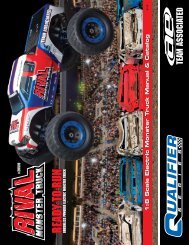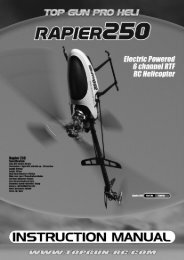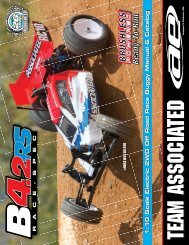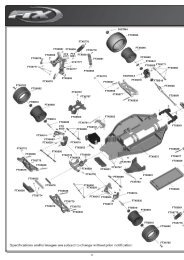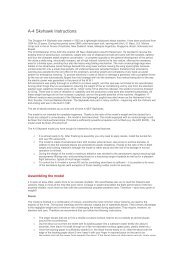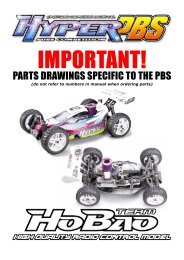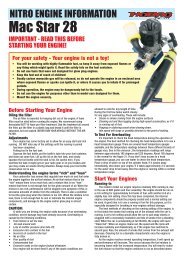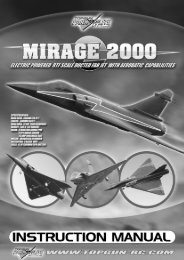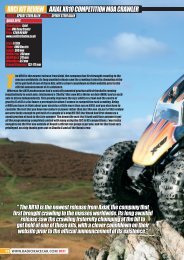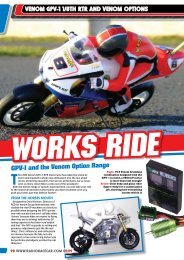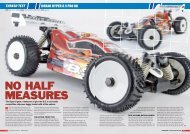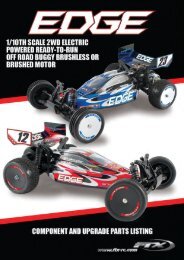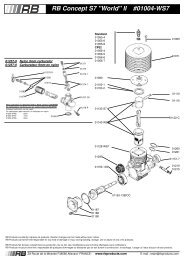HoBao Mini ST reviewed in RRCi - CML Distribution
HoBao Mini ST reviewed in RRCi - CML Distribution
HoBao Mini ST reviewed in RRCi - CML Distribution
Create successful ePaper yourself
Turn your PDF publications into a flip-book with our unique Google optimized e-Paper software.
cifeature<br />
MINI HYPER <strong>ST</strong><br />
<strong>HoBao</strong> Hyper 12 <strong>M<strong>in</strong>i</strong><br />
<strong>ST</strong> Truggy<br />
TARDIS<br />
The popularity of 1/8th Truggy rac<strong>in</strong>g has exploded the world<br />
over, be<strong>in</strong>g so much more stable and forgiv<strong>in</strong>g than a 1/8th<br />
buggy, so this excit<strong>in</strong>g development from <strong>HoBao</strong> br<strong>in</strong>gs you all<br />
the fun and excitement, performance and reliability we have<br />
come to expect from Truggies these days, but <strong>in</strong> a smaller<br />
package for use <strong>in</strong> more conf<strong>in</strong>ed places and smaller 1/10th size<br />
race tracks. With a no compromise attitude to the design brief, the <strong>HoBao</strong><br />
team set to work on a fully featured, pocket version of the extremely<br />
successful Hyper <strong>ST</strong> truggy, and the <strong>M<strong>in</strong>i</strong> <strong>ST</strong> was born. A t<strong>in</strong>y exterior that<br />
is packed full of all the features of larger models; truly a Tardis <strong>in</strong> Truggy<br />
form.<br />
Supplied as a factory assembled Ready-To-Run package, complete<br />
with pre-pa<strong>in</strong>ted shell all you have to do is fit the rear, angle adjustable,<br />
high-level buggy style w<strong>in</strong>g. With an over square chassis with a 29 cm<br />
track width and yet only a 24 cm wheelbase means it is super stable <strong>in</strong> the<br />
corners, by the very fact it is wider than it is long and aided by the front<br />
and rear anti roll bars <strong>in</strong>corporated <strong>in</strong>to both diff cases.<br />
The chassis is already equipped with Futaba 2-channel 27 MHz radio<br />
and is powered by the very popular, powerful, yet easily ma<strong>in</strong>ta<strong>in</strong>ed<br />
<strong>HoBao</strong> Turbo .12 pull start eng<strong>in</strong>e seen <strong>in</strong> previous on and off-road models<br />
over the years. Full of fuel and batteries, ready to race, the <strong>M<strong>in</strong>i</strong> Hyper<br />
<strong>ST</strong> weighs <strong>in</strong> at 2 kg, so straight away you feel this is one sturdy little<br />
package.<br />
FIRE BREATHING<br />
The Hyper 12 Turbo eng<strong>in</strong>e sits at a 20 degree angle to put more of its<br />
weight centrally on the chassis, and it breathes through a pre-oiled, tw<strong>in</strong><br />
layer, low profile, oval air filter and exits via a beautifully polished, EFRA<br />
2645 spec, alloy silencer us<strong>in</strong>g the familiar triple spr<strong>in</strong>g jo<strong>in</strong>t between<br />
pipe and manifold to absorb vibration and ma<strong>in</strong>ta<strong>in</strong> a better seal. In the<br />
usual <strong>RRCi</strong> style we stripped the Hyper Turbo eng<strong>in</strong>e to show you what’s<br />
<strong>in</strong>side, and surpris<strong>in</strong>gly we revealed a pla<strong>in</strong> crank face, not turbo ve<strong>in</strong>ed as<br />
expected. The turbo proclaimed on the eng<strong>in</strong>e label refers to the ve<strong>in</strong>ed<br />
pull start adaptor, as it whizzes around at crank speeds. This turbo fan<br />
will pump the fuel air mixture along, as they transfer from crankcase to<br />
upper cyl<strong>in</strong>der, aid<strong>in</strong>g cyl<strong>in</strong>der fill and boost<strong>in</strong>g the power further up the<br />
rev range.<br />
Although we chose to use the optional Fastrax Bump Box, I’d leave the<br />
pull start <strong>in</strong> place to keep the turbo ve<strong>in</strong> <strong>in</strong> operation. We will keep the pull<br />
start fully functional, rather than fitt<strong>in</strong>g a pla<strong>in</strong> blank<strong>in</strong>g plate, for those<br />
<strong>in</strong>stances when the starter box gets left beh<strong>in</strong>d on race day by mistake.<br />
Oh yes it happens! We fitted a 4200 mAh Intellect Stick pack, and once<br />
charged, it provided enough service to run the eng<strong>in</strong>e <strong>in</strong>, start the eng<strong>in</strong>e<br />
repeatedly on two test days while we got the eng<strong>in</strong>e dialled <strong>in</strong> and learnt<br />
the 4WD driv<strong>in</strong>g style, and also got us runn<strong>in</strong>g throughout a full race day,<br />
qualify<strong>in</strong>g and all, without ever miss<strong>in</strong>g a beat. And it’s still nowhere near<br />
flat even now!<br />
The cyl<strong>in</strong>der cool<strong>in</strong>g head has an <strong>in</strong>tegral head button, with a 0.3 mm shim<br />
between the two, lower<strong>in</strong>g the compression ratio sufficiently to allow the use<br />
of higher Nitro content fuels. We went for the latest Byron Gen 2 RTR 20%<br />
fuel to give a little power boost over the more usual 16% used <strong>in</strong> RTR models<br />
these days. We got two ‘Quart’ (0.95 Litre) bottles, enough for 25 refills so<br />
we aim to use one bottle to run the eng<strong>in</strong>e <strong>in</strong> and set the carb up properly<br />
once it has leaned off, the other to use on a few race days to follow. Hav<strong>in</strong>g<br />
a fuel tank we measured at just 70 ml might not sound like much, ris<strong>in</strong>g to 75<br />
ml once the fuel l<strong>in</strong>e and filter were primed, but a run time of over 6 m<strong>in</strong>utes<br />
at race pace shows just how frugal smaller capacity motors can be whilst<br />
still deliver<strong>in</strong>g the performance required to thrill the driver and w<strong>in</strong> races.<br />
The fuel tank lid <strong>in</strong>corporates a handle with a f<strong>in</strong>ger tip grip for easy refills<br />
on the fly, so it’s probably the first model I haven’t had to add a cable tie to<br />
the lid <strong>in</strong> order to open the tank with the body on! The bodyshell is already<br />
pre-cut and trimmed to <strong>in</strong>clude a large orifice <strong>in</strong> the w<strong>in</strong>dscreen for fuel tank<br />
lid handle access through which cool<strong>in</strong>g air can enter, and the side w<strong>in</strong>dow<br />
is cut out to allow access with a fuel bottle. It’s all geared around quick pit<br />
stops, this is a thoroughbred alright!<br />
The alloy bodied, slide carburettor is designed to rema<strong>in</strong> constant<br />
throughout the heat range of the eng<strong>in</strong>e, meter<strong>in</strong>g fuel accurately enough<br />
to hold its tune and deliver dependable power. With a 5.5 mm venturi the<br />
airflow is measured and restricted sufficiently to make the power delivery<br />
manageable and help improve fuel economy to extend run times.<br />
Hav<strong>in</strong>g no fail-safe <strong>in</strong> the radio nor return spr<strong>in</strong>g on the carb might cause<br />
concern at a race meet<strong>in</strong>g so I’d fit one or the other before your first out<strong>in</strong>g.<br />
NEAT IDEAS<br />
The tw<strong>in</strong> post steer<strong>in</strong>g system uses a cross l<strong>in</strong>k so there’s no Ackerman<br />
adjustment possible, but the servo saver adjuster nut is cleverly placed<br />
above the post so it’s easy to get a f<strong>in</strong>ger to for simple adjustments. Another<br />
clever but simple piece of th<strong>in</strong>k<strong>in</strong>g is the location and angled anti roll bar<br />
bottom l<strong>in</strong>ks, so you can easily get a hex driver to the bolts secur<strong>in</strong>g the<br />
drop l<strong>in</strong>k to the lower arm, without hav<strong>in</strong>g to fight aga<strong>in</strong>st the chassis plate<br />
or suspension arms. Be<strong>in</strong>g angled at almost 45 degrees makes access so<br />
simple you have to wonder why every truck doesn’t do the same!<br />
A composite clutch drives a steel 14T clutch bell and 42-tooth steel spur<br />
gear on the middle differential. Comb<strong>in</strong>ed with the 10-tooth diff <strong>in</strong>put p<strong>in</strong>ion<br />
and 39-tooth diff r<strong>in</strong>gs, equates to an 11.7:1 overall drive ratio. The eng<strong>in</strong>e is<br />
capable of produc<strong>in</strong>g a claimed 1.4 hp at a crazy 37,500 rpm, so it will sp<strong>in</strong><br />
the 2.2" wheels and their 85 mm diameter tyres at 3,200 rpm, equat<strong>in</strong>g to<br />
around 51 kph (30 mph) so it’s a good job the super soft <strong>HoBao</strong> Rac<strong>in</strong>g flat<br />
p<strong>in</strong> tyres are factory assembled to the deep dish, 6-spoke white composite<br />
wheels and properly glued on for you. Be<strong>in</strong>g standard sized 2.2" wheels<br />
means the current range of 1/10th rear hex drive truck wheels will fit so the<br />
76 WWW.RADIORACECAR.COM 10/08<br />
10/08 WWW.RADIORACECAR.COM 77
cifeature<br />
Left: Optional fastrax<br />
‘Bump Box’ makes<br />
start<strong>in</strong>g all 1/18th to<br />
1/12th I/C models a<br />
breeze, and lasts for<br />
ages when fitted with<br />
4200 mAh Intellect<br />
Below: Low profile air filter,<br />
easy grab fuel tank lid and <strong>in</strong><br />
l<strong>in</strong>e fuel filter are all standard<br />
kit<br />
MINI HYPER <strong>ST</strong><br />
Below: Essential<br />
equipment, but you’ll<br />
also need a fuel bottle<br />
and glow start too<br />
Left: Swept lower<br />
arms allow maximum<br />
droop and travel<br />
Below: Radio box has room for full size<br />
receiver and AAA battery pack. Note<br />
transponder mount <strong>in</strong> lid, rubber covered<br />
switch<br />
Right: Pivot ball front<br />
suspension, threaded<br />
alloy shock bodies,<br />
shock boots and<br />
turnbuckle steer<strong>in</strong>g<br />
l<strong>in</strong>ks<br />
Below: Superb kit tyres. CV jo<strong>in</strong>t<br />
captures pivot p<strong>in</strong> <strong>in</strong> bear<strong>in</strong>g. PBS is<br />
super smooth and slop free<br />
Below: Tw<strong>in</strong> post steer<strong>in</strong>g, easy<br />
f<strong>in</strong>ger access servo saver adjuster<br />
nut, additional alloy chassis plate<br />
and diff case braces<br />
Below: Plenty of steer<strong>in</strong>g lock, and a crash<br />
back front bumper mount!<br />
world is your oyster regard<strong>in</strong>g tyre choice, <strong>in</strong>clud<strong>in</strong>g anyth<strong>in</strong>g from the<br />
current Pro-L<strong>in</strong>e range so you should be able to dial <strong>in</strong>to your local track<br />
whether it be AstroTurf, mud or grass.<br />
The centre brake assembly carriers tw<strong>in</strong> steel brake discs are clamped<br />
between fibre l<strong>in</strong>ed pads, and the front to rear brake bias is fully<br />
adjustable thanks to the separate l<strong>in</strong>k rods to the throttle servo. Both<br />
brakes are shielded from fuel spills by a top cover, and the assembly sits<br />
on top of a centre chassis re<strong>in</strong>forcement plate, with struts front and rear<br />
from chassis plate to diff case for extra rigidity. The brake assembly and<br />
centre diff are slightly off centre on the hard anodised chassis plate,<br />
so the propshafts work at a slight angle, but this helps br<strong>in</strong>g the eng<strong>in</strong>e<br />
further towards centre l<strong>in</strong>e, and the fact that the eng<strong>in</strong>e is tilted over<br />
by a whopp<strong>in</strong>g 20 degrees means the mass is central for better weight<br />
distribution and high speed corner<strong>in</strong>g.<br />
SEALED QUAD GEARED TRIPLETS<br />
The three differentials feature both O-r<strong>in</strong>g and gasket sealed cases,<br />
which are huge, accommodat<strong>in</strong>g the oversize planetary and ma<strong>in</strong> gears<br />
with<strong>in</strong>. Hav<strong>in</strong>g four planetary gears spreads the loads and keeps them<br />
very smooth, while a sealed diff case means you can tune their action<br />
with proper silicone diff oils, which begs the question, why are the diffs<br />
just filled with th<strong>in</strong> grease? I would suggest runn<strong>in</strong>g the eng<strong>in</strong>e <strong>in</strong> as<br />
supplied, which will take all the high po<strong>in</strong>ts off the diff gears as well as the<br />
eng<strong>in</strong>e <strong>in</strong>ternals, and then swapp<strong>in</strong>g all three diffs out to a sensible diff<br />
oil, probably follow<strong>in</strong>g the usual practice <strong>in</strong> 1/8th Truggy/Buggy rac<strong>in</strong>g;<br />
7K front, 10K centre and 3K rear diff oil weight. The easy access diff cases<br />
made the job a real breeze, so that’s what we did for race day and it was<br />
spot on!<br />
MY FAVOURITE THINGS<br />
While the rear drive is distributed by good old dependable dog bones,<br />
the front drive shafts have to cope with steer<strong>in</strong>g angles as well as the<br />
range of suspension movement, so thankfully they feature CV jo<strong>in</strong>ts<br />
whose pivot p<strong>in</strong> is held captive with<strong>in</strong> the wheel bear<strong>in</strong>gs so there’s no<br />
escape for the p<strong>in</strong> and the grub screw hold<strong>in</strong>g it <strong>in</strong> place is redundant.<br />
One of my favourite features on any vehicle, reliability built <strong>in</strong> by design.<br />
Another nice design idea I found on re-assembl<strong>in</strong>g the front and rear diffs<br />
(sadly not the centre diff as the output cups drive the brake discs) is that<br />
the bear<strong>in</strong>gs are of such a large diameter that they fit over the output<br />
cups, but why am I so excited? It means you can change the diff bear<strong>in</strong>gs<br />
without hav<strong>in</strong>g to strip the diff completely and remove the output cups to<br />
exchange the bear<strong>in</strong>gs. When you have seen as many trucks and buggies<br />
as I have, it’s the little th<strong>in</strong>gs that impress the most.<br />
The front suspension features pivot ball equipped upper and lower<br />
arms, captive <strong>in</strong> adjustable cover plates, so you can get perfectly<br />
free movement without any slop that would make the steer<strong>in</strong>g feel<br />
unpredictable. The swept lower arms and long travel shocks ensure that<br />
any hard land<strong>in</strong>gs make the chassis plate slap on the floor before the<br />
shocks top out, reliev<strong>in</strong>g any stress on the shock <strong>in</strong>ternals or their alloy<br />
mount<strong>in</strong>g towers.<br />
The alloy shock bodies are threaded for easy ride height adjustments,<br />
and wear a shock rod boot to keep dust and dirt out of the shaft seals for a<br />
longer more reliable work<strong>in</strong>g life. With multiple upper and lower mount<strong>in</strong>g<br />
positions you can dial the chassis <strong>in</strong>to any track or driv<strong>in</strong>g style required.<br />
With spacers on the front upper arm pivots to allow castor changes<br />
and turnbuckles on the steer<strong>in</strong>g l<strong>in</strong>ks plus rear camber connectors you<br />
can really f<strong>in</strong>e tune the chassis, bend<strong>in</strong>g it to your will. The upper rear<br />
arms have multiple <strong>in</strong>ner and outer mount<strong>in</strong>g locations for chang<strong>in</strong>g roll<br />
centres, while the lower arms even have droop screws <strong>in</strong>corporated <strong>in</strong>to<br />
the design, push<strong>in</strong>g directly aga<strong>in</strong>st the chassis plate to limit the down<br />
travel of front and rear arms, allow<strong>in</strong>g you to dial <strong>in</strong> the handl<strong>in</strong>g on extra<br />
bumpy conditions, or hunker it down when the go<strong>in</strong>g gets fast and smooth.<br />
The lower arms are a ladder style for maximum strength, moulded<br />
<strong>in</strong> a material that is sufficiently pliable to absorb the knocks and keep<br />
on runn<strong>in</strong>g. Reliability is most def<strong>in</strong>itely the key to any successful race<br />
chassis. To f<strong>in</strong>ish first, first you have to f<strong>in</strong>ish!<br />
The only tun<strong>in</strong>g features I can see absent from its bigger brothers is the<br />
eccentric <strong>in</strong>serts used <strong>in</strong> the lower pivot l<strong>in</strong>k plates to allow quick rear toe<br />
changes, so I presume optional l<strong>in</strong>k plates will be available to allow this<br />
simple yet crucial tun<strong>in</strong>g aid. More rear toe adds stability at high speed<br />
over bumpy ground at the cost of turn<strong>in</strong>g ability. Less rear toe makes for<br />
a sharper steer<strong>in</strong>g truck but it will be far more nervous on the high speed<br />
section of the track. Set at 3 degrees is a typical sett<strong>in</strong>g so perhaps <strong>HoBao</strong><br />
have done all the sums and test<strong>in</strong>g for you and set it that the optimum<br />
condition straight from the box. The front-end is set with a good degree<br />
of toe out to make it responsive to steer<strong>in</strong>g <strong>in</strong>puts, giv<strong>in</strong>g a good <strong>in</strong>itial<br />
response, and putt<strong>in</strong>g the front suspension through its range there is<br />
negligible bump steer so it rema<strong>in</strong>s stable and accurate over even the<br />
roughest terra<strong>in</strong>.<br />
The blue anodised alloy radio tray holds two full size H-101 servos, so<br />
you can easily upgrade these at a later date if you f<strong>in</strong>d yourself need<strong>in</strong>g<br />
better steer<strong>in</strong>g or throttle response. The radio box holds a 4 AAA battery<br />
case and a full size 27 MHz receiver, but it is cavernous, easily big enough<br />
to get a little Novak LiPo and regulator <strong>in</strong> there to speed up the servos.<br />
The radio switch lives on the side of the radio tray and wears a rubber<br />
cover to afford it some wet weather protection, and the radio box lid<br />
clamps all cables with<strong>in</strong> grommets to help prevent moisture <strong>in</strong>gress. The<br />
radio box lid also <strong>in</strong>corporates a three-po<strong>in</strong>t mount<strong>in</strong>g for the AMB PT<br />
(Personal Transponder) you will need on race day. It mounts from <strong>in</strong>side,<br />
face up so you can read your transponder number from the outside with<br />
the top face flush with the radio box lid, what a great touch. It’s a shame<br />
the radio lid is reta<strong>in</strong>ed by three screws <strong>in</strong>stead of R-clips, as you will<br />
need to open it regularly if runn<strong>in</strong>g 27 MHz to change crystals at a race<br />
meet<strong>in</strong>g, and to recharge or swap the receiver batteries as there is no<br />
78 WWW.RADIORACECAR.COM 10/08<br />
10/08 WWW.RADIORACECAR.COM 79
cifeature<br />
Below: Eng<strong>in</strong>e mounts<br />
tilt the weight <strong>in</strong>board<br />
by 20 degrees<br />
MINI HYPER <strong>ST</strong><br />
Left: 3 large ports <strong>in</strong><br />
ABC l<strong>in</strong>er, large cool<strong>in</strong>g<br />
head and turbo ve<strong>in</strong>ed<br />
bear<strong>in</strong>g case keep the<br />
power flow<strong>in</strong>g<br />
Below: Flush hard<br />
anodised alloy chassis<br />
has diff cases, spur<br />
gear, fly wheel and pull<br />
start recesses to get<br />
everyth<strong>in</strong>g as low as<br />
possible<br />
Below: Straight from the box with EFRA spec<br />
alloy pipe and spr<strong>in</strong>g loaded manifold jo<strong>in</strong>t<br />
Below: Centre diff<br />
with bias adjustable,<br />
tw<strong>in</strong> brake set-up, fuel<br />
splash shields and<br />
steel spur gear<br />
Left: Four planetary<br />
gears share the load.<br />
O-r<strong>in</strong>g and gasket<br />
sealed diff case means<br />
oils can be used to tune<br />
the action<br />
QUICK SPEC<br />
Class: 1/12th 4WD Off Road Truggy<br />
Type: RTR Nitro<br />
Manufacturer: <strong>HoBao</strong><br />
Price: £175.00 RRP<br />
remote lead <strong>in</strong>corporated <strong>in</strong>to the switch. If you were to convert it to 2.4<br />
GHz radio and <strong>in</strong>stall rechargeable batteries, simply swap the switch for<br />
one with a remote charge lead and you will never need to open the radio<br />
box lid aga<strong>in</strong>!<br />
RACE DAY<br />
After runn<strong>in</strong>g <strong>in</strong>, and a successful test day round the full AstroTurf track<br />
at Bag<strong>in</strong>ton, where we cut some decent 30 second laps <strong>in</strong> impressive<br />
style, clear<strong>in</strong>g the famous double jump repeatedly and cop<strong>in</strong>g brilliantly<br />
with the bumps, we did a few modifications before the Summer series on<br />
Coventry’s mostly grass summer track. Install<strong>in</strong>g a XP1015 servo gave us<br />
the steer<strong>in</strong>g speed and reliability I need for rac<strong>in</strong>g, while a LiPo receiver<br />
pack and regulator provided the power to speed up the standard throttle<br />
servo.<br />
I fitted my PT <strong>in</strong>to the radio box lid, and checked it all over for loose<br />
screws but there was noth<strong>in</strong>g else to do, it was still box stock chassis<br />
geometry and I hadn’t even twiddled the shock pre-load r<strong>in</strong>gs! It flew<br />
round the grass track, clear<strong>in</strong>g the new improved triple jump with just a<br />
blip of the throttle to keep the nose up. The kit tyres worked beautifully<br />
on the short dry grass track and AstroTurf jump sections, offer<strong>in</strong>g plenty<br />
of steer<strong>in</strong>g response for sharp corner<strong>in</strong>g without even a h<strong>in</strong>t of grip roll<br />
thanks to the front and rear anti roll bars fitted as standard. I took the<br />
first two rounds of qualify<strong>in</strong>g to give me Pole Position on the packed<br />
1/12th Truggy A-F<strong>in</strong>al grid and was <strong>in</strong> a comfortable lead until the eng<strong>in</strong>e<br />
cut, with a stone lodged between the chassis and flywheel. While I was<br />
stationary await<strong>in</strong>g a sun-baked marshal to scoop me up, another truggy<br />
hit it full belt and pulled a pivot p<strong>in</strong> through the rear suspension arm. We<br />
had thrash tested it to destruction and not managed to break or bend<br />
anyth<strong>in</strong>g so I was a little surprised, not to mention disappo<strong>in</strong>ted not to w<strong>in</strong><br />
the A-F<strong>in</strong>al but hey, that’s rac<strong>in</strong>g; always full of surprises! At least now we<br />
know what spare parts to stick <strong>in</strong> the pit box before the next race day!<br />
After stripp<strong>in</strong>g and rebuild<strong>in</strong>g the Hyper <strong>M<strong>in</strong>i</strong> <strong>ST</strong> I realised I hadn’t<br />
seen a s<strong>in</strong>gle C-clip, and that all fix<strong>in</strong>gs were proper hex drive screws<br />
and nyloc nuts, so no corners cut <strong>in</strong> the design and construction at all.<br />
I was well impressed, not a s<strong>in</strong>gle fiddly circlip to wrestle with and not a<br />
s<strong>in</strong>gle stripped screw head; Quality through and through. The Hyper 12<br />
<strong>M<strong>in</strong>i</strong> <strong>ST</strong> had proved a competent and competitive package, and we still<br />
can’t figure out how they build so many features, so much strength and<br />
performance <strong>in</strong>to such a small package. Just like the Tardis!<br />
This is no toy replica of the proper Truggy; it IS a proper Truggy, just<br />
1/12th scale. One for the kids? If it’s tough enough to handle a full race<br />
pace and some seriously fast tumbles, then maybe it will survive their<br />
best efforts, if they can wrestle it from my grip between race meet<strong>in</strong>gs!<br />
There is a race series planned later this year for just 1/12th Truggies and<br />
1/10th Trucks, so keep your eyes on the <strong>CML</strong> website and <strong>RRCi</strong> news<br />
pages for further details. <strong>RRCi</strong><br />
Left: Wider than it is<br />
long, for stable high<br />
speed corner<strong>in</strong>g<br />
REQUIRED AND RECOMMENDED<br />
Receiver Batteries: Intellect AAA x 4<br />
Radio Batteries: Intellect AA x 12<br />
Fuel: Byron Gen 2 RTR 20%<br />
Fuel Bottle: Fastrax<br />
Glow Plug: Fastrax Plat<strong>in</strong>um #4<br />
Glow Starter: Fastrax FA<strong>ST</strong>50<br />
OPTIONS<br />
Bump Box Start – FA<strong>ST</strong> 562<br />
Intellect 4200 mAh Stick Pack<br />
DISLIKES<br />
No quick access radio box, the lid is<br />
screwed on<br />
LIKES<br />
Full size Truggy Spec<br />
Fully ballraced<br />
Fully adjustable geometry<br />
Full size radio gear<br />
Turnbuckle adjusters<br />
Anti-roll bars fitted F and R<br />
Steel primary drive gears<br />
Captive CV jo<strong>in</strong>t p<strong>in</strong>s<br />
Hardened metric Hex fix<strong>in</strong>gs<br />
C-Clip free assembly<br />
CONTACT<br />
<strong>CML</strong> <strong>Distribution</strong>,<br />
Tel: 01527 575349<br />
www.cmldistribution.co.uk<br />
80 WWW.RADIORACECAR.COM 10/08<br />
10/08 WWW.RADIORACECAR.COM 81



